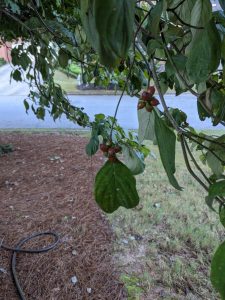
I love to do this post every year. Here in NE Georgia the birds stop eating bird seed and suet right around Labor Day. The wild birds don’t completely stop eating but it is a noticeable difference in consumption.
Why…
The answer is simple. 1st the great fall migration is happening. Wild birds are leaving (towhees, catbirds, hummingbirds, etc) and new ones haven’t quite arrived (millions of sparrows, juncos, warblers, etc).
The 2nd reason is hiding in plain sight! The trees and bushes are fruiting. The picture shown here is a dogwood, those red berries will be bluebird crack in just a few days. My serviceberry in the backyard is about to pop with 1000s of berries. Frost grapes will be coming soon. Acorns, and tree nuts in general are dropping.
Yep, it’s a darn good time to be a bird in NE Georgia.
So, no… there is nothing wrong with your suet or seed right at this moment. Your feeder now has a lot of competition. Don’t worry, the wild birds will come back!
